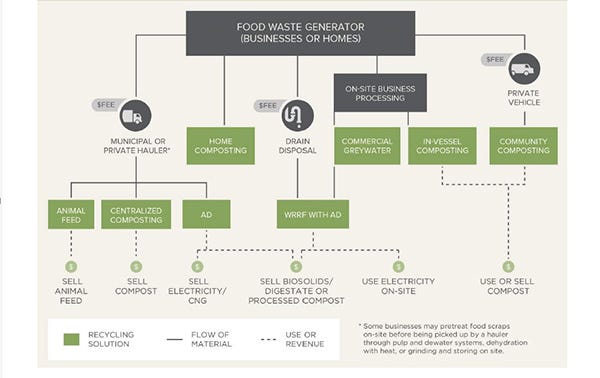Seven Key Takeaways from ReFED’s Roadmap to Reduce U.S. Food Waste Report
Rethink Food Waste Through Economics and Data (ReFED)—a collaboration of more than 30 business, government, investor, foundation and nonprofit leaders dedicated to reducing U.S. food waste—has released its first-ever national economic study and action plan report entitled The Roadmap to Reduce U.S. Food Waste by 20 Percent, which highlights 27 solutions to reduce U.S. food waste by 20 percent.
The 27 solutions in the report are designed to help the U.S. stay on track to achieve the national food waste reduction target of 50 percent by 2030, which was established by the U.S. government last fall.
The Roadmap plan is estimated to create over 15,000 jobs, reduce 1.5 percent of national freshwater use, double the amount of meals donated to relieve hunger and divert approximately 18 million tons of greenhouse gas emissions.
In order to reach the targeted food waste reduction goal, ReFED has outlined four priority actions in the Roadmap:
Hundreds of millions of dollars of new catalytic funding must be galvanized.
Policymakers must make pragmatic changes to tax incentives, safety regulations and permitting procedures to support healthy market solutions.
The U.S. must develop new technology and business-model innovations.
A sweeping education and awareness campaign is needed to change behavior both among consumers and employees of food business.
Below, you will find seven key takeaways from The Roadmap to Reduce U.S. Food Waste by 20 Percent report.
Food Wasted by Weight
The Roadmap has broken down food waste into four segments: farms, food manufacturers, consumer-facing businesses and homes. Consumer-facing business and homes make up over 80 percent of all food waste, while farms and manufacturers make up roughly 18 percent of the total food waste in the U.S.
Breakdown of Consumer-Facing Businesses
The consumer-facing businesses in the report include distributors, retail grocers, restaurants, foodservice providers, institutions and the government. While approximately 30 percent of U.S. food waste is recovered or recycled primarily by manufacturers, less than 10 percent of food waste derived by consumer-facing businesses and consumers is recovered or recycled.
Financial Costs of Waste
The annual financial cost of food waste for all four sectors is $218 billion, which costs the consumers the most ($144 billion) due to the difference in retail pricing versus wholesale pricing for consumer-facing businesses. Farms, manufacturers and consumer-facing businesses bring in a total cost of $74 billion annually.
Breakdown of Food Waste by Weight and Type
Approximately 80 percent of food waste comes from perishable foods, which include prepared fresh deli items, meats, fruits and vegetables, seafood, milk and dairy and some grains like bread and other bakery items. Fruits and vegetables, which are the most expensive food types, make up over 40 percent of the food waste total, while meat and seafood are the least wasted and the most expensive food types.
Prevention Solutions
This report reveals that prevention creates three times the societal net Economic Value of recovery and recycling combined. Consumer Education Campaigns and Standardized Date Labeling are the two most cost-effective solutions, and they require low investments to provide new information to consumers on shifting wasteful behavior.
Recycling Solutions
Recycling is the most scalable path to reduce national food waste. Technologies for recycling organic, biodegradable materials have existed for years, and more than half of the organics recycled come from composting lawn clippings and manure. To create a closed loop system that supports an agricultural sector, energy independence and greener cities, food scraps need to be harvested. The Roadmap analysis also shows that approximately three-fourths of food waste reduction comes from recycling.
Recycling Value Chain
This recycling value chain shows a number of different food waste generators for businesses or homes, such as selling animal feed, using and selling compost, selling electricity/CNG, selling biosolids/digestate or processed compost and using electricity onsite.

Chart courtesy of ReFED
About the Author
You May Also Like




